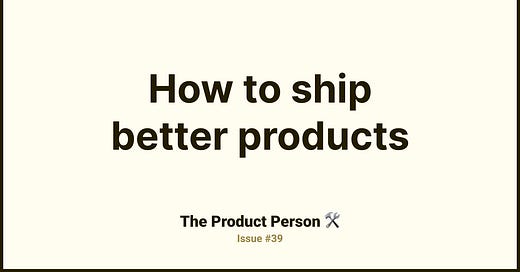TPP #39: How to ship better products
hi, Anthony here! Every week, I find articles and posts around the web about product development and how to build great products. Then I summarize and share them here.
Let’s get to it!
Shape Up
Lately, I’ve been reading (and loving) Shape Up by Basecamp.
And there are 2 simple, yet powerful, concepts in it that I think will help you create better products:
Start with a number, end with a design
Fixed time, variable scope
Start with a number, end with a design
Begin a project by explicitly deciding how much time you’re willing to spend on it.
(In Shape Up, they call this your “appetite”)
Do this before you design anything.
Before you write any code.
Before you buy a domain.
Here’s why:
Starting with a number (your appetite) allows you to gauge how much of your attention the idea deserves.
Think of it like a time budget.
If you have an idea and you just start building it without an appetite, you’re allowing unlimited time and unlimited resources to that idea without realizing it.
You’ll keep postponing the “launch”
You’ll build any feature that sounds good
You’ll spend any money/time on it
When you start with an appetite, you’re scrutinizing the idea from the get-go.
You’re implicitly asking:
“Approximately, how much time/resources do I need to build this thing?”
“What tools will I need to use?”
“Is this even feasible?”
“What parts of building this will most likely slow me down?”
By setting your appetite (ie. 2 weeks, 6 weeks, a weekend, etc), you’re suffocating the fantasy out of the idea and bringing it down to reality.
You’re asking: “Realistically, what will this project cost me in time and effort?”
It’s a way to evaluate ideas more objectively. So that you don’t get too excited about any one idea. Or even if you’re not excited about an idea, you can still think with a clear mind about what it’ll take to develop the solution.
Fixed time, variable scope
An appetite gives you fixed time.
Along with the fixed time, keep your scope flexible.
The appetite forces you to make decisions and trade-offs.
The flexible scope allows you to make those decisions by letting you remove any tasks or features that might get in your way of finishing within the appetite.
Example
So let’s say you want to build a dating app.
It’s a cool idea. But, you decide that you don’t want to spend months and months working on it. So, you set your appetite for 6 weeks.
6 weeks to release an MVP.
You start. You have a long list of features that you want to add to it. But with 6 weeks, you’re not going to be able to add them all. You’ll have to make decisions.
The goal is end up asking questions like:
“I have all these feature ideas but I have limited time, which ones are essential?”
“Which features can I not build and still end up with a useful product?”
“This one feature will take 3 weeks to build, but I only have 6 weeks. Is there a way to solve that use-case, but with a smaller, simpler feature?”
“Is that use-case even important?”
“I have one week left. Should I still add feature D, or should I focus on testing features A, B, and C to make sure they’re done well?”
Conclusion
Knowing when to stop is one of the hardest parts of building a product. You could always add more or improve what’s there.
But, by setting an appetite, you force yourself to make trade-offs.
And, with a flexible, variable scope, you give yourself the time and space to make those trade-offs.
In the end, you’ll produce simpler, more focused products.
🔗 You can read Basecamp’s Shape Up for free online on their site. I highly, highly recommend it.
Expect some more Shape Up concepts in this newsletter :)
End Note
Thanks for enjoying The Product Person. I’d love it if you shared it with a friend or two. If this was shared to you, you can subscribe here.
❤️ Hit the heart button as well, it helps a lot.
Have a great day,
Anthony
(P.S. Is there something I can help you with? Reach out to me via email or set a date)







